The final set of Safari’s first forays into dinosaur miniatures features a charming blend of aesthetics, and also serves in retrospect as a tribute to a dawning hobby and its burgeoning artists.
In 1994, Battat was commissioned by the Boston Museum to produce what would become one of the most praised toy lines in dinosaur collecting. The Battat Museum dinosaur line was unparalleled in sculpt quality and scientific accuracy for their time, and many of these figures hold up (mostly) even under scrutiny today. Before Battat’s line was released, the two sculptors hired to design the figures – Gregory Wenzel and Dan LoRusso – were cutting their teeth on designs for another toy company. Safari ltd. was still new on the industry stage, and one of their first lines in the early 1990s was the Authentics Habitats line – themed sets of animal minifigures representing specific groups or environments. A total of three of these sets ended up being dinosaur-themed.
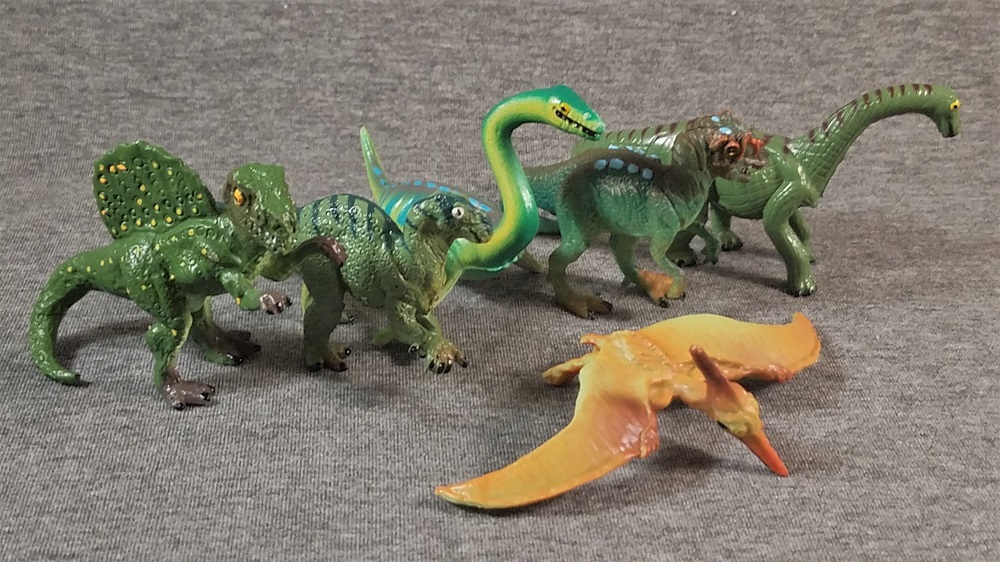
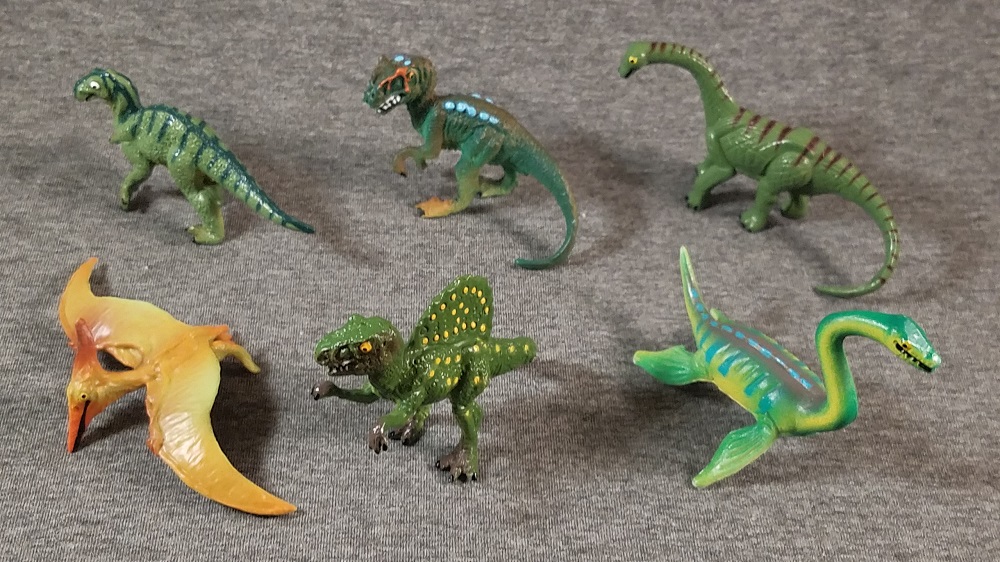
Each of Safari’s Authentics Dinos sets had a different sculptor. For the first set, Safari recruited their leading sculptor for the Carnegie Museum collection, Forest Rogers. For the second set, Gregory Wenzel of future Battat fame produced the designs. For the last set, Dinos III, Wenzel’s colleague Dan LoRusso was the designer. Each set has its own unique appearance, courtesy of the respective artists: Rogers’ dinosaurs have a stylized, old-fashioned look, while Wenzel’s dinos strive for more accurate and naturalistic appearance. LoRusso’s sculpts hover somewhere in between Rogers and Wenzel in aesthetic, with some figures looking slightly more realistic and others looking more obviously stylized.

There are two of each general “type” of dinosaur featured in the Dinos III set. Allosaurus is one of two theropods, and one of the more semi-realistic figures. Posed in a mostly horizontal stance with the tail curved for balance, this Allosaurus is lean and long-limbed, with its neck sharply curved in an S for observation and attack. The skull features the genus’s signature lacrimal horns/ridges, as well as speculative armored scales on top of the head and along the back. Circular scale texture is pressed into the sculpt on most of the body, and the neck shows creased and folded skin texture to match the posture. The overall sculpt can look a bit sloppy from some angles, but a lot of anatomical detail is packed into this miniature Jurassic lion.
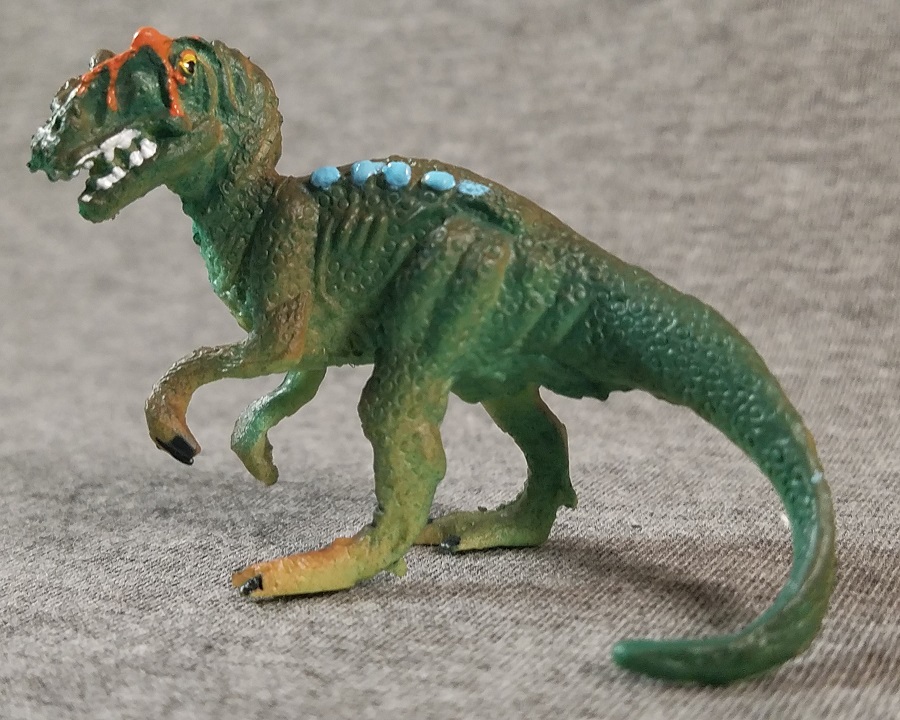
Allosaurus is painted in a deep green gradient, with a brown wash along the back and sandy-brown hands and feet. The face is highlighted by red lacrimal ridges and yellow eyes, with solid sky blue for the larger scales. Although application is sloppy in some areas, the overall color scheme is pleasing to the eye and nicely varied for a toy of this size. Other versions of the toy exist with different coloration; the Authentics figurines were released and re-released multiple times over the years. A second copy in my possession is painted in a flat, dark aqua hue, with faint purple highlights to the spine. The red facial ridges and blue scales are also darker shades. Interestingly, even the sculpt itself shows changes, perhaps due to aging of the original mold; the facial features and feet are less defined, while the skin texture is unexpectedly more pronounced than before.
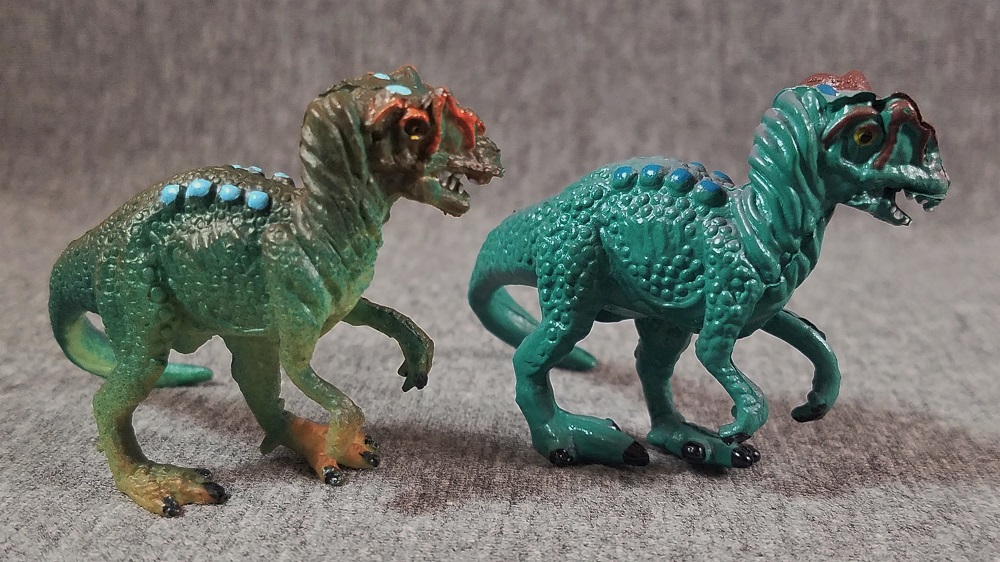
While Allosaurus fares pretty well in the Authentics line, the second theropod in this set, Spinosaurus, is showing its age more. A massive, boxy tyrannosaurine skull with pronounced brow ridges and exposed fenestrae sits atop a squat neck, with a perfectly round half-oval sail raised from its back. The rest of the body is generically theropodian, with old-fashioned pronated hands (Allosaurus is guilty of this to, in fairness) and respectfully long hind legs. Circular scale texture is impressed into the body again, as well as along the sail in semi-uniform manner. Although it’s hard to tell at this size whether or not the design has shrink-wrapped anatomy, the torso does feature an oddly bulged rib cage. The tail curves down to balance the toy in a tripod stance; the effect is a little more obvious than with the Allosaurus.
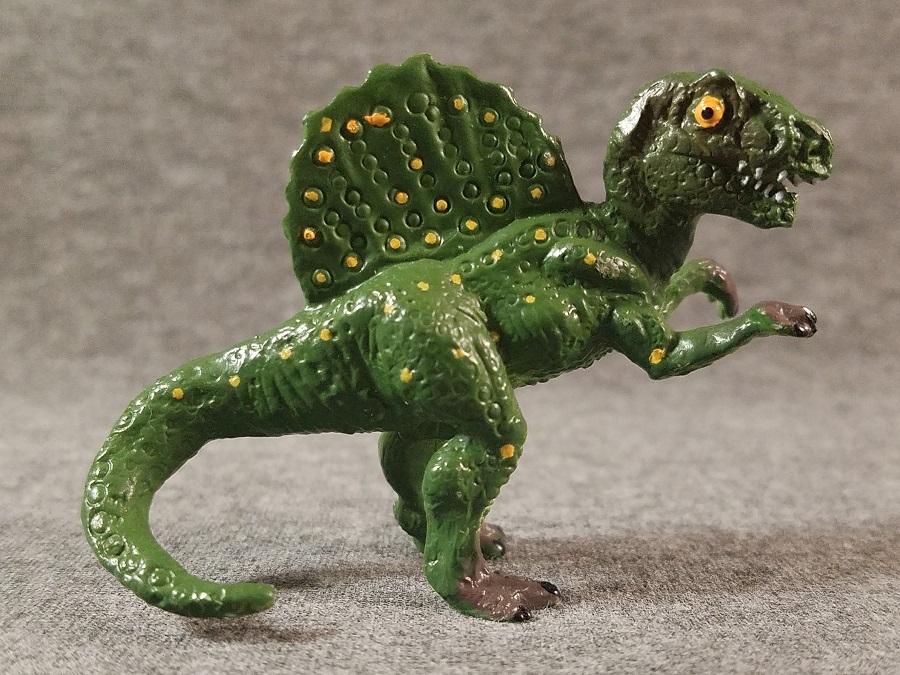
Coloration on Spinosaurus seems a bit more consistent between reissues. I have two Spinosaurus in my collection, both of which are a dark green with reddish-brown washes to the face, feet, and a couple of other spots. Yellow polka dots fill in rows of circular scales along the body and sail, and white highlights mark the teeth while black highlights mark the claws. The primary difference between versions (mine, at least) is in the saturation of the colors and the glossiness of the finish. Overall, while the aesthetics of the figure are similar to the Allosaurus of the same set, the result is rather less effective here and looks more badly dated. Ironically, of the two theropods, it is the Spinosaurus which has seen an extended life repurposed as a Toob minifigure across multiple more releases.
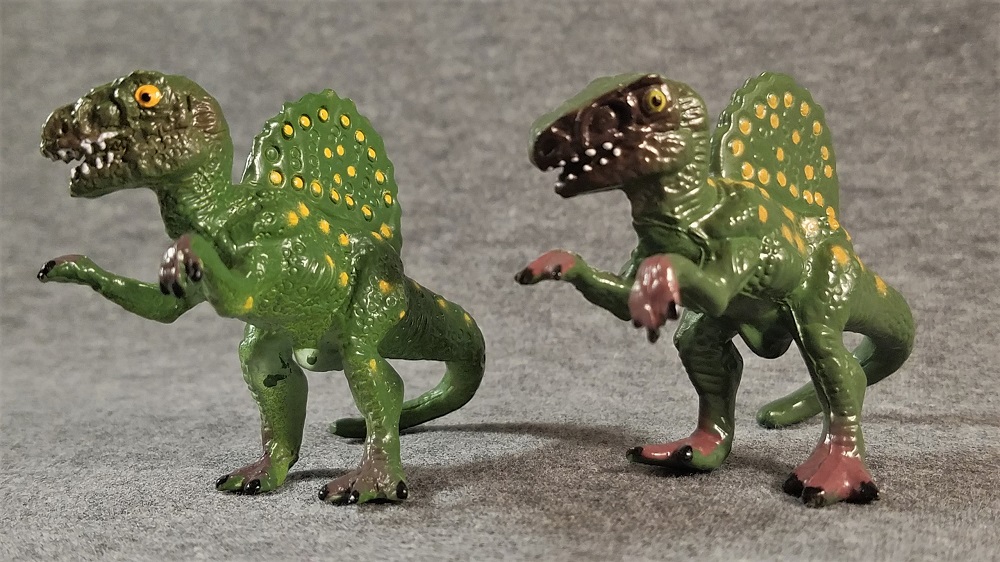
Pairing with the Allosaurus in a different manner is Diplodocus, a fellow Jurassic genus and one of two herbivorous dinosaurs in the set. At a glance, Diplodocus appears rather cartoony; the toy has smooth, glossy details with very broad cross-stitched skin texture, and large round eyes on a flat head. However, this is also a very lively-looking critter, with its neck raised high and its sweeping tail almost entirely off the ground. The sauropod is depicted as lean and limber (perhaps a bit too much so) – a far cry from the traditional lumbering tail-draggers that were still prevalent in much of dinosaur media (including Safari’s own Carnegie main line). The head is still very flat and nondescript, but faint nostrils can be made out halfway down the snout – perhaps a compromise between interpretations of sauropod nasal cavities.
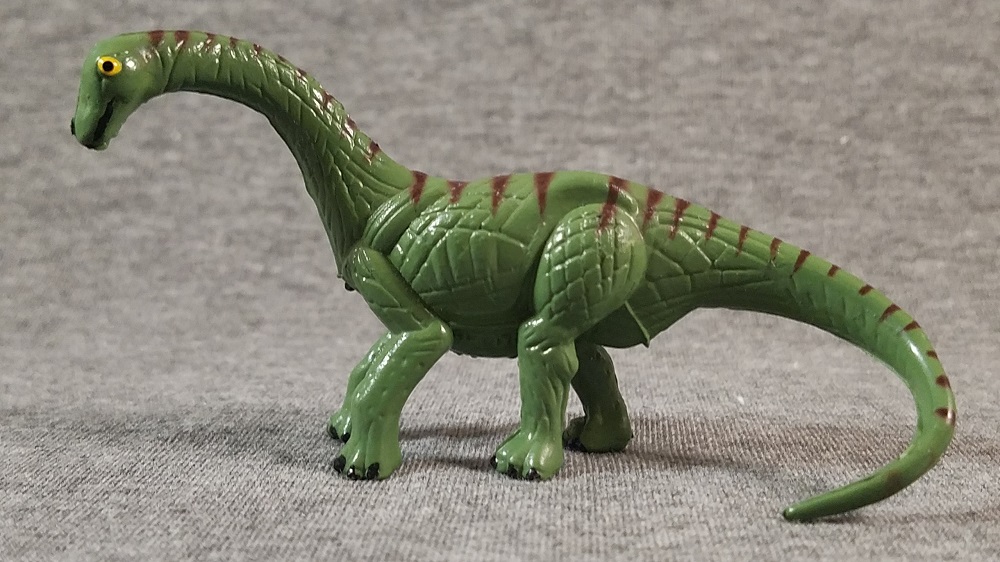
Diplodocus is colored a simple solid forest green, with dark red stripes running perpendicular down the length of the backbone. The eyes are bright yellow with black pupils, and the individual toes are marked black as well. The specific shades may vary between releases, but otherwise coloration seems to have remained consistent on this figure. In the early 2000s, Japanese company Colorata released knockoffs of multiple Authentics figurines, many of which had bright new color schemes; even then, however, Diplodocus remained predominantly dark green, the biggest difference lying in the stripes, which were now a shade of green as well.
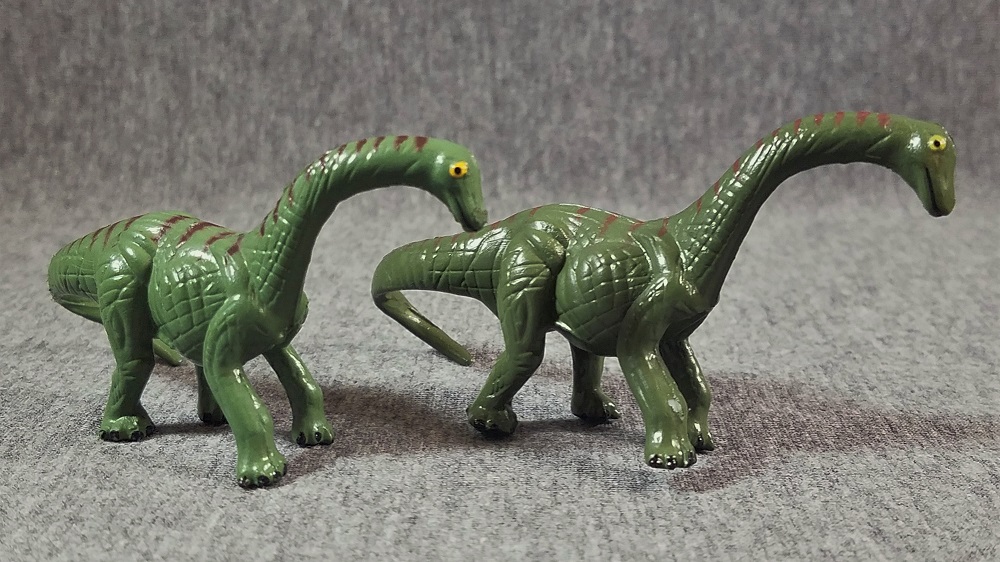
The second herbivore in the set is the classic Iguanodon, representing the ornithischian side of the dino family tree. Iguanodon has seen more than its fair share of reconstructions and revisions over the decades; LoRusso’s little sculpt does a good job at depicting the thumb-spiked herbivore in an appropriate “renaissance”-era style. The animal is posed makeshift on all fours with one arm raised, tail held straight out and fairly rigid. The neck looks thick but flexible, and while a beak isn’t discernible the skull does feature a large, rounded snout. Round scale texturing returns on this figure, a little better defined than on the theropods. The body is deep, but narrow; admittedly the back is arched into an exaggerated hump to help achieve this effect. The hands, thankfully, are sculpted large enough to display the animal’s signature thumb and digits.

Iguanodon continues the green theme for this set, borrowing the forest-green-with-stripes pattern from Diplodocus and the brownish hand-and-foot highlights from the theropods. Additional yellow highlights are present on the underbelly of some copies, and the quantity/saturation of the reddish-brown for the limbs can vary. It’s not a bad color scheme, but following the other three dinos covered it does feel very redundant. Both Iguanodon and Diplodocus continue to see life repurposed as Toob miniatures for Safari ltd. today.
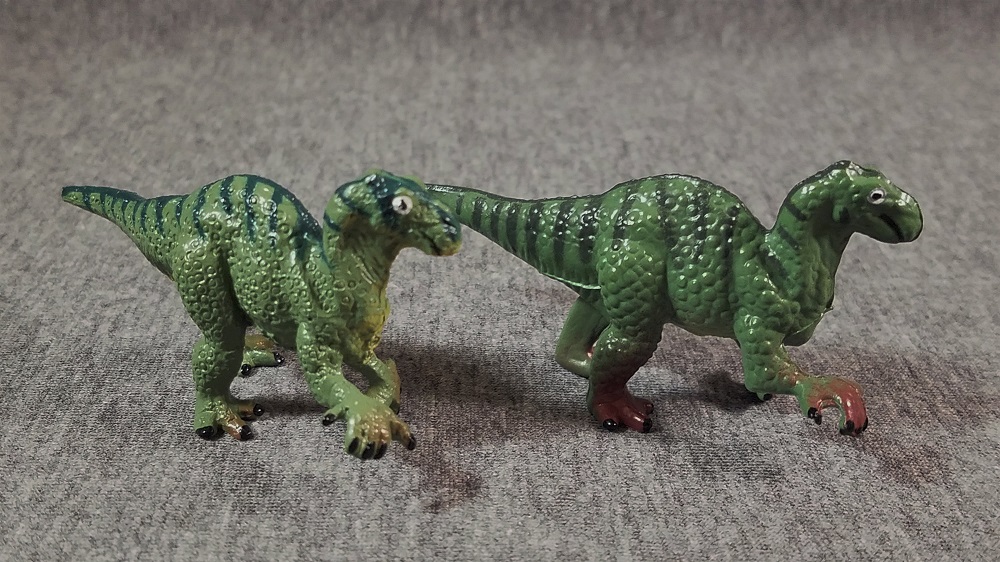
The third Dinos Authentics set doesn’t exclusively feature dinosaurs; two famous contemporary animals also are featured. Of the two non-dinosaurs, Elasmosaurus definitely leans toward the cartoony side. A dramatically S-curved neck culminates in a large, smiling head. The body is predominantly smooth, although minimal striations on top and underneath seem to suggest the ribcage’s presence. The four flippers have a veined texture on top, resembling fish fins. The flippers are also posed angling downward, propping up the figurine off the ground slightly. While there’s no mistaking the body plan of a plesiosaur, the Authentics Elasmosaurus is certainly the silliest-looking figurine of the set.
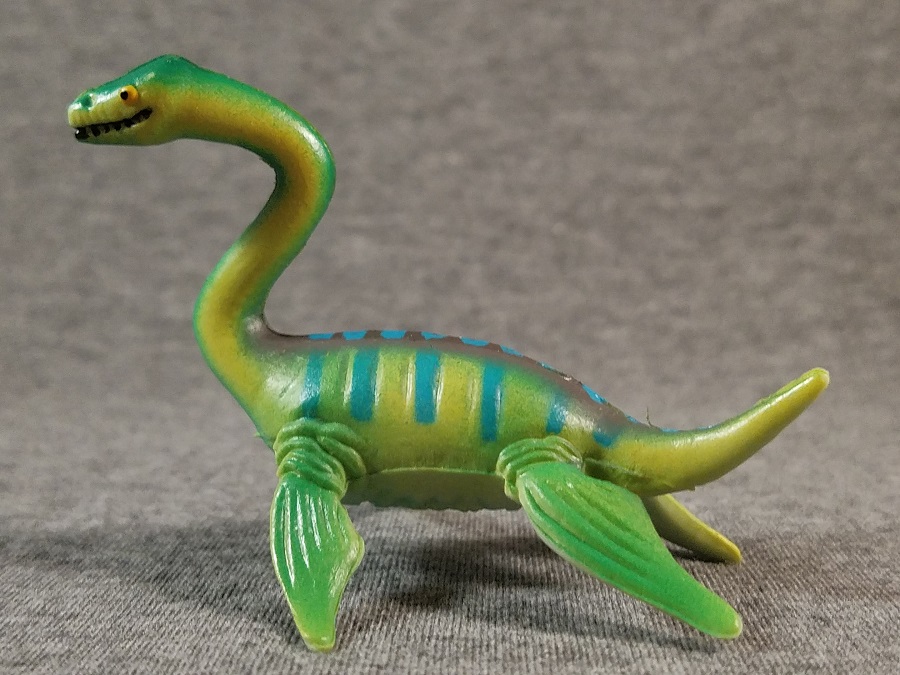
Elasmosaurus also gets what might be the most toyetic color scheme of the set – although this comes with the benefit of breaking up the monotony of green somewhat. Elasmosaurus does feature a saturated green spray on its neck, head, and flippers; but much of the neck and body are bright yellow, with rows of aqua blue stripes along the back underneath a purplish spray. A final dotted line of sky blue running directly over the backbone and tailbone tops off this most vibrant tropical color scheme. Depending on one’s copy, the application of these different color layers may vary in hue, saturation, and general quantity. The few copies I’ve seen, though, all have buggy yellow eyes and a silly grin thickly highlighted in black.
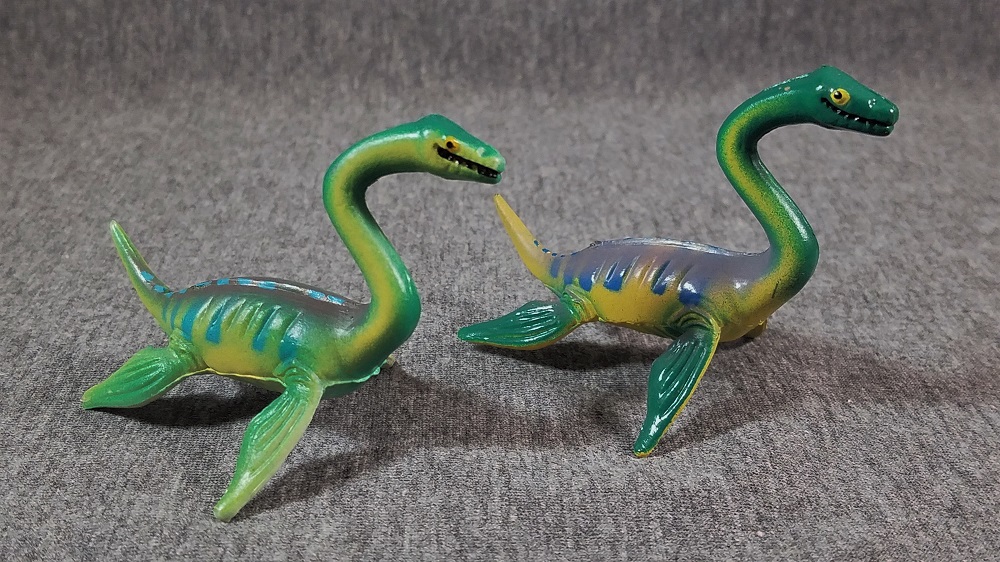
The second non-dinosaur, and the final figurine of the Authentics Dinos III, is the iconic flying reptile, the pterosaur Pteranodon. Although still a little cartoony in appearance, Pteranodon’s seems to strive for more of a balance in style. The beak and crest are relatively well-defined, although the big eyes and black-highlighted smile detract from the appearance somewhat. The wings are appropriately long, and the arms – although noodly – appear to follow generally accurate shape and position to frame the leathery membranes. It’s worth noting that the membranes don’t attach to the hind limbs or the tail, however. There’s a bit of a pot belly, but overall the torso is quite small, as is proper for most large pterosaurs. A bit of a throat pouch is evident on the neck, and faint striations on the back and belly might be a ribcage or maybe even pycnofibres.

Coloration for Pteranodon is, shockingly, not green at all, but gradients of brown and tan, with orange and greenish tints, respectively. This can vary between copies, of course, as is usual for Authentics figurines; but the general pattern of dark-to-light patches, from the torso extending out to the wings and head, appears to be consistent. It’s a simple, but effective pattern, and a welcome change from the ever-present green patterns that seem to have dominated this set.
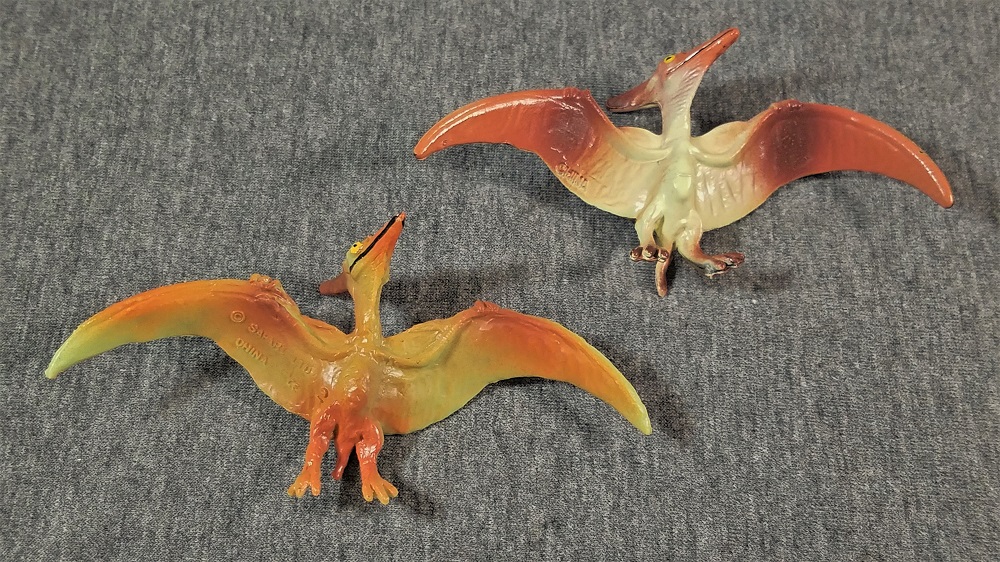
Dan LoRusso would go on to work underneath Battat, once again alongside Gregory Wenzel, in producing far more impressive dinosaur figures for the next couple of years. In 2016, LoRusso would return to Battat to resurrect their old dinosaur line; but after Dan’s tragic passing from illness the following year the line ground to a halt once again. Safari’s Authentics Dinosaurs series stand as early testaments to three artists who have become legends in their own rights among dinosaur collectors, and to an era when dinosaur science and pop culture were changing dramatically forever. The Dinos III set has its hits and misses, but makes a charming group together, and a memoir to an influential artist in this small corner of the toy industry who departed all too soon. Although no longer in production, the Authentics figurines can often show up in scattered listings on eBay and other auction/resale sites for reasonable prices. They’re well worth a little hunting, if you ask me.

Support the Dinosaur Toy Blog by making dino-purchases through these links to Ebay and Amazon. Disclaimer: links to Ebay.com and Amazon.com on the The Dinosaur Toy Blog are often affiliate links, when you make purchases through these links we may make a commission

The plesiosaur is Elasmosaurus, not Plesiosaurus, which can be seen here: https://dinotoyblog.com/forum/index.php?topic=1550.0
Thanks for the correction; I have made the appropriate updates. I’m not sure how I made that mistake when I referenced that very thread among other sources!
Definitely not as interesting as the #2 collection but I’ve always loved that derpy plesiosaur.
A very green collection LOL; I think I like Version 2 better as there is a little more color variety with the additional detail